Here, we will report on the class and student activities of Toji and Kyoto City University of Arts “Introduction to Conservation Science ‘Toji’ Picture Scroll Making” (instructor: Shigeo Uno).
Production of picture scrolls of Toji Temple
On July 22nd (Wednesday), the production of the picture scroll finally started.
Until now, classes have been held at Campus Plaza Kyoto and Toji Temple, but this time they were held at Kyoto City University of Arts, where the studio is located. In the class, Mr. Uno first gave a lecture on the types of brushes used in Japanese painting, how to draw with each brush, and how to use ink and paints.
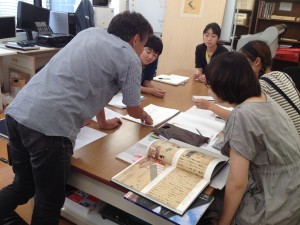
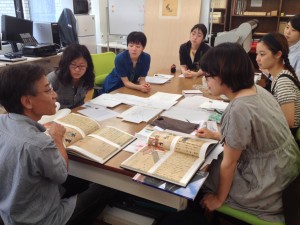
As a result of repeated research and interviews at Toji Temple, it was decided to draw a picture scroll with three themes: “Rengemon”, “Sanko no Matsu”, and “Five-storied Pagoda”.
The students will be divided into three teams and will be in charge of each theme. Teams are made up of students from Kyoto City University of Arts and students from other universities with whom credits are exchanged.
“Rengemon” depicts the legend that occurred when Kobo Daishi Kukai passed through the gate to depart from Toji Temple to Mt. Koya.
In the “Sanko no Matsu”, when Kobo Daishi Kukai went to Tang for training, he threw a Sanko (Buddhist implement used in Esoteric Buddhism rituals) toward the sea on a sandy beach in Tang, hoping for the prosperity of Esoteric Buddhism. However, after passing through the clouds and crossing the sea, he draws a legend that after returning to Japan, it was hung on the pine tree of Toji Temple given by the emperor.
“Five-storied Pagoda” depicts how the five-storied pagoda was burned down and rebuilt repeatedly during its long history of 1,200 years.
While some students were creating Japanese paintings for the first time this time, the team exchanged opinions, checked the drawings, and asked Mr. Uno for advice as they proceeded with the work.
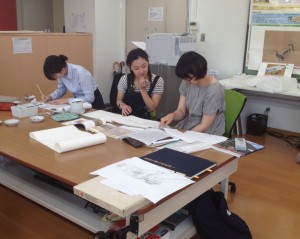
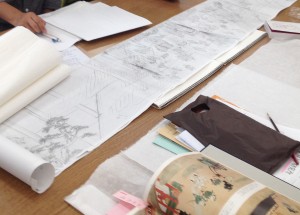
During the summer vacation, the students will proceed with the production of the parts they are in charge of by self-study.
Second Toji Interview
On June 10th (Wednesday), I tried my second interview at Toji Temple. It has been a month since our last interview with Toji Temple on Wednesday, May 13th.
This project is also in the second half, and the subjects to draw in the picture scroll, such as the lotus gate, the five-storied pagoda, and Kukaijin, have been decided. This time, in order to gather the necessary information (historical facts, episodes, etc.) necessary for creating the story of the picture scroll and actually drawing it, we interviewed Mr. Niimi, the manager of the cultural property protection section of Toji Temple, who is familiar with materials and documents related to Toji Temple. I did an interview. During the interview, the students actively asked questions, perhaps because of their learning from the training, their previous experiences, and the results of their preparation. In addition to the main theme, there were also questions unique to art university students, such as confirming the details drawn in the picture scroll, such as the townscape and scenery around Toji in the era when each episode occurred, and the sense of the season.
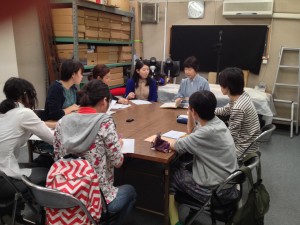
In addition, the information that the students had researched in advance was a mixture of historical facts and legends. I also received advice that it is important to set up.
Interview Training -Try an interview at Toji Temple
interview training
On May 9th (Sat), former NHK announcer Yoshihiro Mori will be invited as a lecturer for an interview training jointly with Professor Wakamatsu’s class at Kyoto Sangyo University, whose classes are held at Kamigamo Shrine. I did. Interviews with people involved in World Heritage sites and local residents are extremely important in order to deepen our understanding of the World Heritage sites, and in the process of discovering issues and proving hypotheses for solutions. Uno-sensei’s class is scheduled for an interview at Toji Temple on Wednesday, May 13th.
According to Mr. Mori, interviewing is one of the most difficult tasks for an announcer. In the limited time of 90 minutes, he explained in an easy-to-understand manner about how to prepare for an interview, the necessary preparations, and interview techniques that even beginners can use, including his own experiences. rice field.
The students listened intently to Mr. Mori’s enthusiastic lecture and took notes.
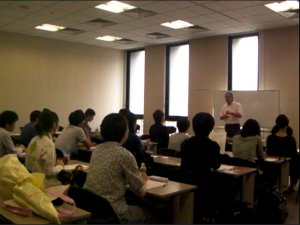
After the interview training, a strategy meeting was held based on the content of the training for the next class. We discussed the necessary preparations for the day of the interview and the division of roles on the day.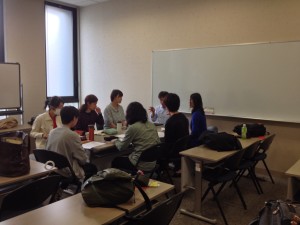
Interview at Toji Temple
On May 13th (Wednesday), I visited Toji Temple and interviewed Mr. Sunahara, the general manager of the general affairs department, in order to obtain hints on the subject matter of the picture scroll. Toji has a history of 1,200 years, and there are many things that can be used as subjects, such as important cultural properties, national treasures, and episodes of great people related to Toji, such as Kobo Daishi. In this interview, the students researched Toji Temple in advance and interviewed Director Sunahara about their concerns and interests to deepen their knowledge. . The students were interviewed on a wide range of topics, including the origins of the names of the gates at Toji Temple, their roots, Buddhist statues, the life of Kobo Daishi, and events that have survived to this day, such as the Kobo Market.
The student who conducted the interview said, “I was able to hear what I wanted to hear to some extent, but I received more information than I expected, and it was difficult to summarize. I want to narrow it down.”
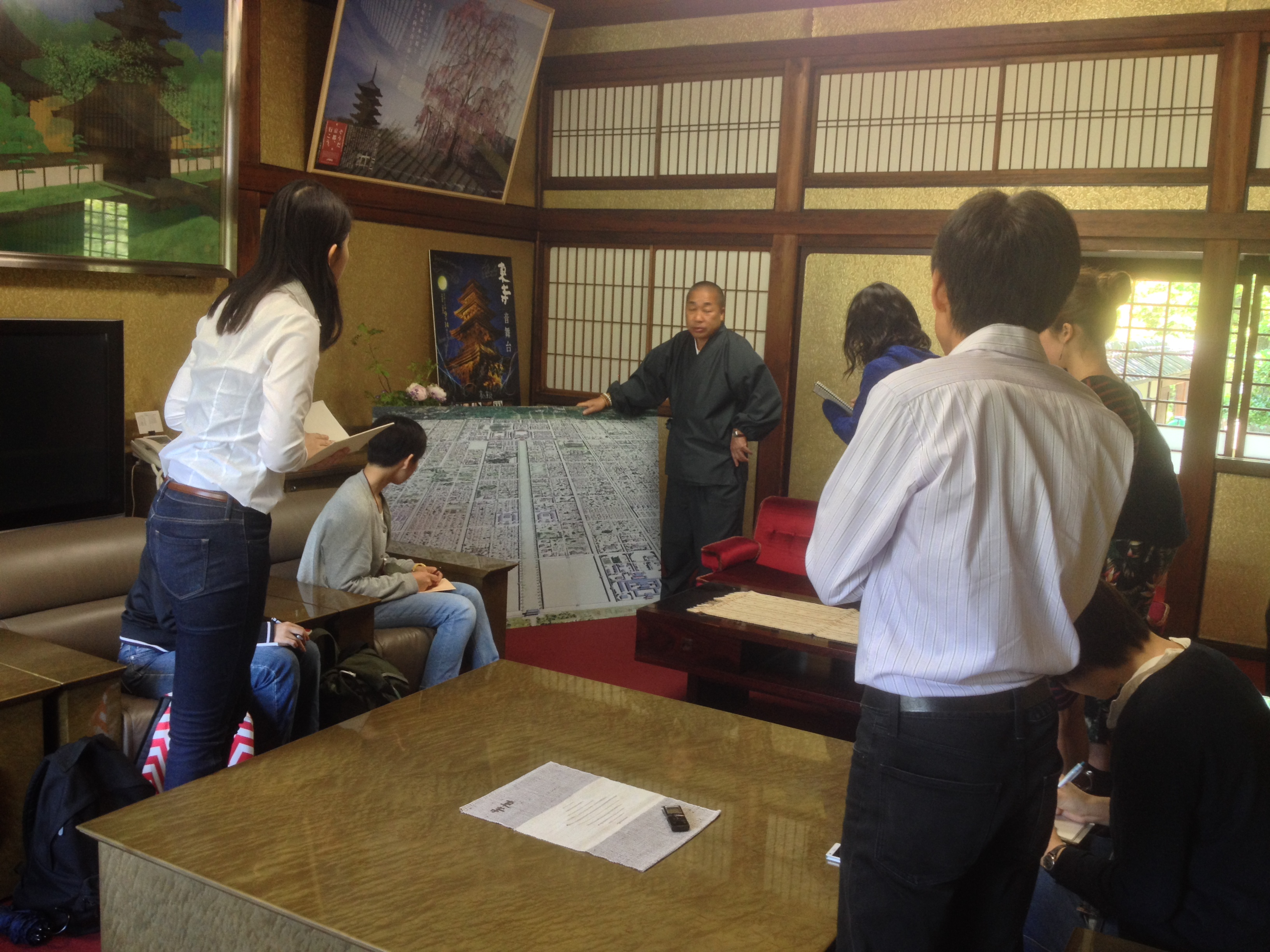
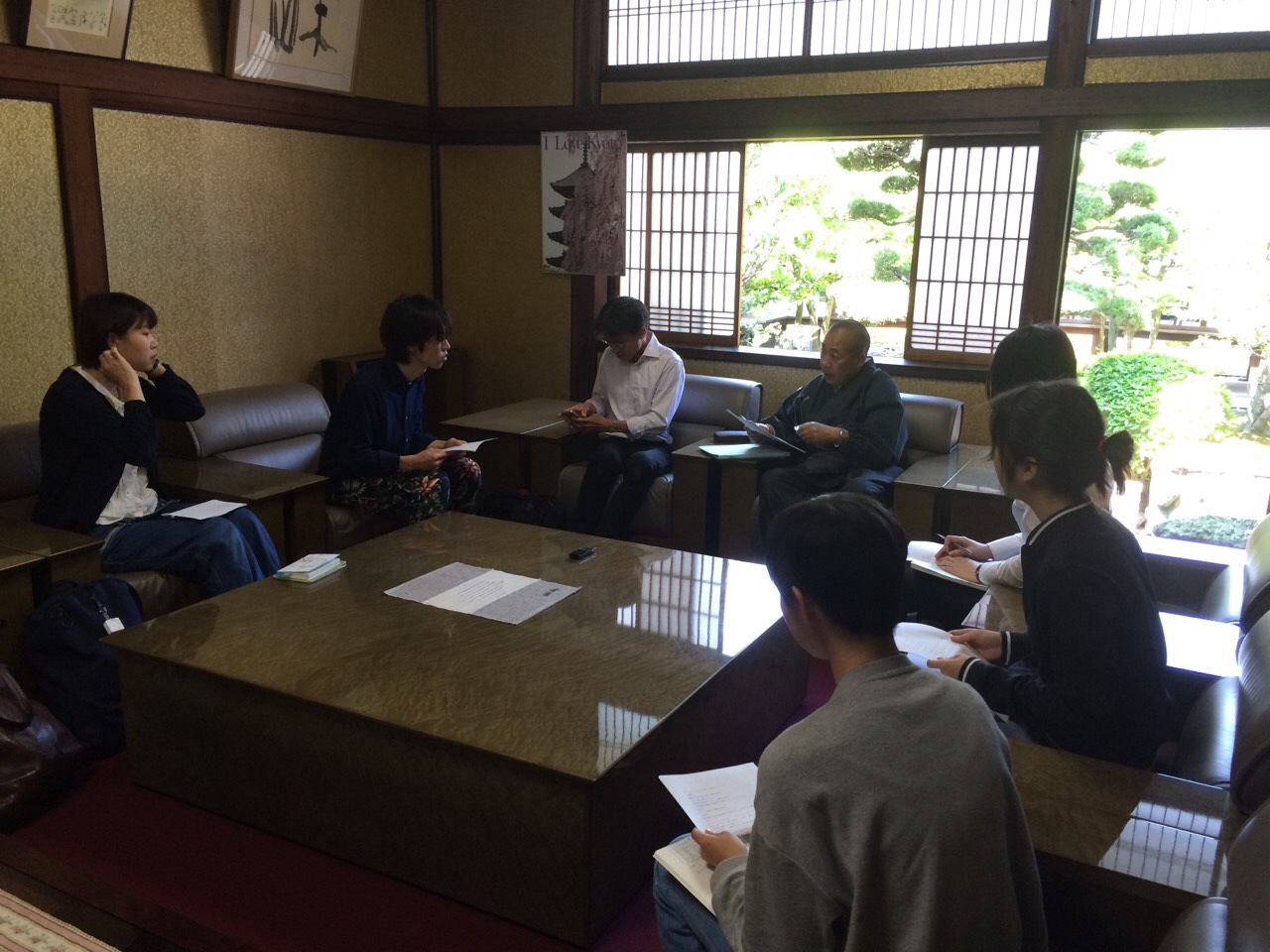
After the interview, Director Sunahara took us on a tour of places that we were not able to see during our previous visit to Toji Temple.
First class – First visit to Toji Temple
This class started on April 15 (Wednesday) ahead of other World Heritage PBL courses. The theme of this course is “Using the traditional expressions of Japanese painting, create an original record that you want to pass on to future generations.” In keeping with the theme, Mr. Uno explained the characteristics of traditional Japanese paintings such as picture scrolls.
Current recording media have disadvantages such as deterioration due to color fading in the case of photographs, and the inability to play records due to technological progress in the case of digital devices. Due to the excellent properties of the material, it has vividly survived several hundred years ago, and by using unique techniques such as “Iji Dozu” and “Exaggeration and personification”, the events of the time are effectively depicted. It was explained that it is possible to convey clearly to
In the latter half of the class, students made illustrations and presented their self-introductions and their enthusiasm for the class, which is unique to art colleges.
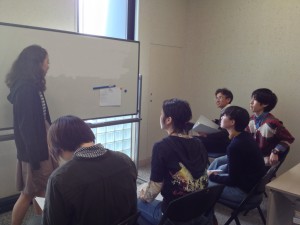
On April 22 (Wednesday), we actually visited Toji Temple and toured the precincts under the guidance of Mr. Sunahara, general affairs manager of Toji Temple. He carefully explained the valuable cultural assets of Toji Temple, which has a history of 1,200 years, and the willows and anecdotes related to Ono Dofu, a calligrapher of the Heian period who is also known as the Sanseki. I was.
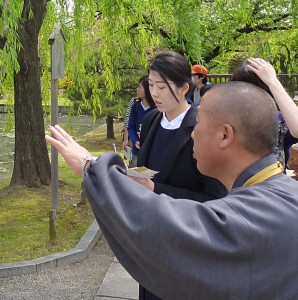
Contact information
Public Interest Incorporated Foundation Consortium of Universities Kyoto Credit Transfer Program
TEL +81-75-353-9120 FAX +81-75-353-9121
Campus Plaza Kyoto, Shimogyo-ku, Kyoto 600-8216
*Reception hours: Tuesday-Saturday 9:00- 17:00 (excluding year-end and New Year holidays)















